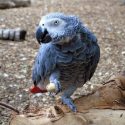
African Grey Parrot Natural History
Size
These birds have an approximate length of 33 cm (13.2 inches) and a weight of 400 grams.
Habitat and Distribution
The African Grey Parrot inhabits lowland forests throughout western and central Africa including Angola, Cameroon, Tanzania, Ghana, Congo, Nigeria, Kenya and United Republic of Uganda.
Age
In captivity they have an average lifespan of 50 years. However, they can live as long as 80 years.
Diet
These parrots mostly eat seeds, nuts and fruit, particularly berries. Their strong hooked beak is well adapted for cracking open nuts and seeds. They have also developed a taste for grain.
Groups and Breeding
In the wild these birds usually breed between July and September, nesting in tree holes near water. Females tend to their 2-5 eggs while males provide food for the females. Once hatched chicks are cared for by both parents and will stay in the nest for roughly three months.
Threats
This species is listed as Endangered by the IUCN. Their biggest threats are loss of habitat and capture for the pet trade. These are one of the most popular avian pets in the United States, Middle East and Europe due to their ability to mimic sounds and speech as well as for their long lifespan.
Interesting Facts
African Grey’s are the largest parrot’s native to Africa.
The African Grey Parrot During Your Day Out in Kent
Our African grey parrot, Jack joined us in 2020. He can be seen in our communal long flight enclosure alongside a number of other parrot species including galah cockatoos and yellow-crowned amazons. Jack is a very chatty boy so make sure you stop and say hi to him! His enclosure can be found opposite the education building and visitors can head straight from here to the entrance of the Tropical House to visit many other free flying birds including crowned pigeon, white cheeked turaco and rainbow lorikeets.
The more you know…
Want to know more about this animal? Check out our keeper blogs about them here.